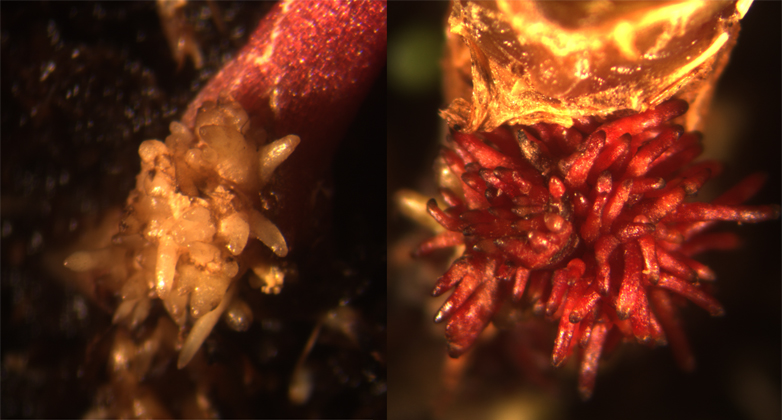The groundbreaking Freshman Research Initiative (FRI) program at The University of Texas at Austin helped a pair of students put a coveted feather in their cap quite early in their academic careers: the chance to say they’ve been published in a top-tier scientific journal from the prestigious Nature Publishing Group.
The College of Natural Sciences’ FRI program is the nation’s largest program to allow first-year students access to dedicated labs and opportunities to do cutting-edge, original, publishable research. Students in FRI, for many years, have had their research published in peer-reviewed journals, with over 150 such papers co-authored by FRI students appearing in journals over the nine years of the program. However, this is the first time FRI students’ work has made it into a journal with an impact rating at the top for its field, says Eman Ghanem, FRI’s Assistant Director.
FRI alumni Lee Elam and Austin Hembd co-authored the paper, a study on the regulation of the betalain red pigment in plants such as beets, in the December edition of Nature Genetics, which is cited more often than nearly any other journal on genetics and heredity, according to the Thomson Reuters Journal Citation Report. Both students participated in the FRI research stream, “Epidermal Cell Fates and Pathways,” run by Professor Alan Lloyd of the College of Natural Sciences and FRI Research Educator Tony Gonzalez. Both Lloyd and Gonzalez are co-authors on the paper, along with first author Greg Hatlestad, another FRI Research Educator in Lloyd’s lab.
When Elam and Hembd found out their paper was featured on the home page of a prestigious journal this month, both were impressed, but expressed that the real highlight for them was the opportunity to participate in hands-on research.
 At the time Elam joined Alan Lloyd’s FRI stream in her second semester, her future was uncertain. She was pondering multiple options, and her experiences in the lab helped her realize her path.
At the time Elam joined Alan Lloyd’s FRI stream in her second semester, her future was uncertain. She was pondering multiple options, and her experiences in the lab helped her realize her path.
“I ended up really liking research a lot more than I thought I would, so I wanted to do something where I could continue doing research,” said Elam, who is now attending medical school at The University of Texas Medical Branch at Galveston. “The work got me a lot more interested in genetics because I got hands-on experience with it.”
Elam’s work in the FRI stream inspired her to join Lloyd’s lab as a laboratory assistant for the rest of her undergraduate career.
“She expressed a strong interest in continuing research at the next level,” said Gonzalez.
In addition to other projects, Elam helped with several aspects of the research presented in the paper, including sequencing of the beet genes and genetically altering the beet cells to test different hypotheses.
 Hembd’s experiences in undergraduate research also helped inform his future, redirecting his path to medical school.
Hembd’s experiences in undergraduate research also helped inform his future, redirecting his path to medical school.
“I did other research projects with people in different labs and found that those with MDs who still wanted to do research on the side could do that,” said Hembd, who is currently in medical school at The University of Texas Southwestern Medical Center at Dallas.
Hembd’s work in the FRI stream led to him working two summers in Lloyd’s lab as an FRI Summer Research Fellow. Among other projects, Hembd contributed to the Nature Genetics paper by running special tests, called yeast two-hybrid assays, which helped identify some of the proteins involved in the making of beet pigments.
The techniques and skills learned in FRI help with research in medical school, too, Elam and Hembd said. Elam has conducted research with the Ob-Gyn department at UTMB Galveston, which won her the 2013 Norma H. Rubin Prize for Excellence in Research. Hembd has done multiple research projects with faculty at UT Southwestern and a summer research fellowship with Vanderbilt University’s urology program.
In the Nature Genetics article, the authors reveal for the first time what is regulating the color in plants that use betalain pigments. Betalain pigments are what make beets, prickly pear cactus, quinoa, and several other species red or yellow, which is unusual because the rest of the plant kingdom uses anthocyanin as a pigment.

Using a number of genetic, molecular and biochemical experiments the researchers identified the gene, BvMYB1, which controls the use of this color. They found that the regulating gene is the same one used to control anthocyanins in other plants, but has been co-opted by these plants to use the different pigment.
The Freshman Research Initiative at The University of Texas at Austin is serving as a model for other colleges and universities looking to modernize how they teach science in the 21st century. Forty percent or more of FRI students come from populations underrepresented in the sciences, and participation in FRI increases the likelihood of students remaining in scientific career paths. Because the initiative has tangible benefits and helps new students gain critical thinking, technical and problem solving skills, it is being replicated at other universities, some of which will be represented at a national conference on FRI in Austin next summer.

















Comments